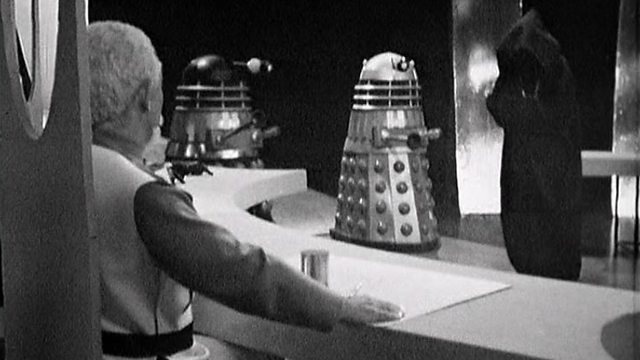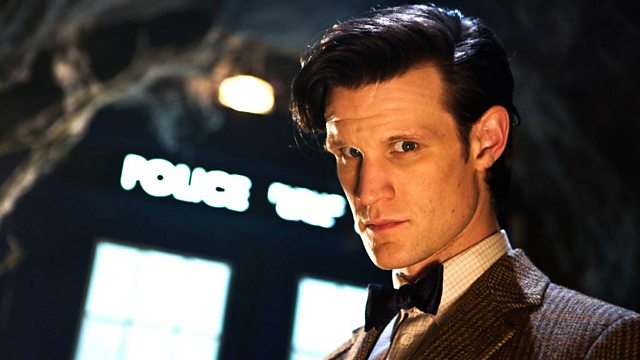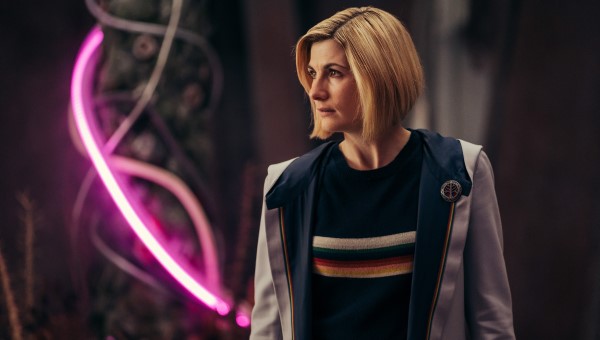The climax of Doctor Who’s most ambitious epic in years is nearly here.

Season premiere ‘The Halloween Apocalypse’ gleefully threw half a dozen narrative balls into the air, making clear this would be no ‘Bad Wolf’ style loose strand connecting stand alone stories. When Chris Chibnall unveiled Doctor Who: Flux as the show’s first six-parter since the 1970s, he wasn’t playing around. Series Thirteen represents a dense and complex web of plot strands. Those iconic images of our heroes entangled in colourful strips winding their way in every direction might be describing the scripts of these Doctor Who episodes as much as the Flux phenomenon itself.
Even on Earth alone, the action has romped from the heart of Liverpool to quiet English villages, to the mountains of South America to the Great Wall of China. In space we’ve travelled from a planet of acid to a space station outside the universe itself, taking in Outpost Rose, the Temple of Atropos and more along the way. All things considered, the scripts have kept their various interlocking subplots largely clear and understandable. Audiences’ biggest challenge has been trying to anticipate how these apparently unrelated events will ultimately join up, with many of the answers to different puzzles being held back across several episodes. But one thing we can be sure of is that this isn’t the first time Doctor Who episodes have been this ambitious with their storytelling.

Long complicated plots were regular features of classic Doctor Who episodes
Flux’s variety of locations has plenty of precedent in classic Doctor Who episodes at least. Longer serials would keep the action fresh with frequent literal changes of scenery. ‘The Keys of Marinus’ (1964) is set on a single planet, but visited Marinus’ isolated pyramids, tropical jungles, icy mountainsides, and metropolises. ‘Frontier in Space’ (1973) was even bigger in scope, taking the Doctor from deep space to the Earth, to a penal colony on the Moon, and to the planet Draconia before the final battle on the Ogron homeworld.
Marinus’ writer (and creator of the Daleks) Terry Nation went even bigger with the truly vast twelve parter ‘The Daleks’ Master Plan‘ (1965/6). That saw the Doctor’s arch-enemies chase him across five planets, and from the year 4,000 AD to ancient Egypt. While the array of locations and time zones in ‘The War Games’ (1969) is so extensive even the characters in story need a giant table map to keep track. By comparison, the fourteen part ‘The Trial of a Time Lord,’ despite being the only Doctor Who story with a longer runtime than Flux, is fairly leisurely. The trial itself barely moves from one room, and the evidence – in the form of three of the Doctor’s adventures, one each from his past, present, and future – stick to one main location per segment too.

Pre-Flux, modern Who added narrative complexity to shorter stories
Modern Doctor Who episodes until Flux has tended to focus on fewer locations. Even Martha’s global trek in ‘Last of the Time Lords’ happens off camera. Instead later Doctor Who episodes invest their complexity in their narrative structure. Russell T Davies played with this throughout his era. The ‘Bad Wolf’ mystery was revealed to the consequence of something Rose Tyler hadn’t even done yet, for instance.
But Steven Moffat made such timey-wimey plots his own. The incredibly influential ‘Blink’ turns on the Doctor reading from a piece of paper copied down from him reading it out. ‘The Wedding of River Song’ features all of history happening simultaneously as mere background detail. Winston Churchill as a Roman Emperor and Charles Dickens on BBC One would be enough for most writers. But Moffat makes the crux of his plot two competing versions of the same event, one where River Song shoots the Doctor and one where she doesn’t. Yet consequences and memories carry over from one to the other. If you want the ultimate Doctor Who head scratcher, ask yourself the simple question: is Madame Kovarian alive or not?
Steven Moffat retains his crown as the undisputed King of Timey-Wimey
In fact, the entire Eleventh Doctor era is an intricately complex sequence of Doctor Who episodes playing out back to front. It may not be structured as one story but it commands the audience pay close attention across three series. In Matt Smith’s very first episode Prisoner Zero declares that “Silence will fall.” In his very last episode we learn it’s been all about preventing his actions now. While it’s the Silence themselves, in trying to stop the Doctor, that create River Song (who actually saves his life), and accidentally create the same cracks in time that allow Prisoner Zero to escape and tell the Doctor to beware the Silence in the first place! It’s an arc that only bears thinking through in detail if you have some paracetamol handy.
A stiff drink might be appropriate before pondering River Song’s tangled storyline. “Who is she?!” asked everyone after ‘Silence in the Library / Forest of the Dead.’ But full marks to anyone who guessed she was secretly the daughter of the Doctor’s best friends that we hadn’t even met yet.

Doctor Who: Flux’s diverse strands are finally coming together
By comparison, Doctor Who: Flux is pretty straightforward. There’s lots of characters and questions and time travel. Characters are introduced in early episodes without any hint of how they’ll later get involved in the main arc. But everyone experiences events in more or less the same order. When the fam reunite this weekend mere hours will have passed for the Doctor and three years for her friends. But they’ll have the same shared history; it won’t be a Yaz who hasn’t met the Doctor yet, or a Dan who’s already seen the Doctor’s future death.
Even the Grand Serpent’s machinations in ‘Survivors of the Flux’ unfold for the viewer in an orderly way. A Moffat version might have started in 2017 before unspooling backwards in time as the Grand Serpent kept tweaking reality to get the result he wanted. Though let’s take a moment to acknowledge the confidence of Flux’s storytelling. A time travelling villain retconning fifty years of UNIT history would normally be the whole plot of an episode. Here it’s merely a piece of a much larger puzzle.
Will ‘The Vanquishers’ deliver satisfying answers?
As we head into ‘The Vanquishers’ the diverse strands are coming together. The Doctor has a plan to save the universe, and is placed for a final confrontation with the Ravagers. Her lost memories are within her grasp, and Division seemingly crippled. Vinder has a plan, too, to free Passenger’s prisoners, and has teamed up with Diane. Yaz, Dan and Jericho have discovered the purpose of Williamson’s tunnels and need only find the one to bring them back to 2021. Bel and Karvanista stand ready to defend the Earth from the Sontarans, while Kate and her UNIT team also poised to join the fight.
(For a full breakdown of all of the characters from these latest Doctor Who episodes, see here.)
With sixty minutes of Doctor Who: Flux remaining, it’s all heading in one definite direction. Will the ending hit the target, though? Or will it leave viewers scratching their heads once more? Let us know your predictions for the ending…

Thirteenth Doctor scarf – order now from the Lovarzi shop!
Shop on Amazon
Latest posts…
- The Reality War: The story behind the Fifteenth Doctor’s regeneration
- What would a Doctor Who missing episodes drama be like?
- Wish World: Another alternate reality story for the Doctor
- Doctor Who history: The Doctor’s silliest moments
- Doctor Who: The most shocking moments from The Interstellar Song Contest


Leave a Reply